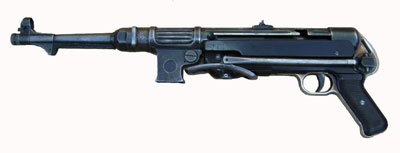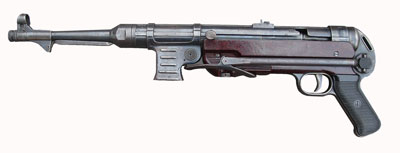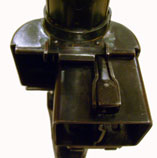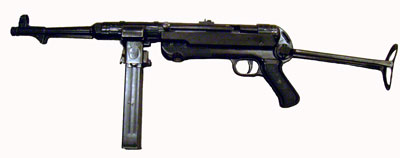|
Models
Berthold
Geipel founder of the Erfurter Maschinenfabrik (ERMA) developed based on
German Army funding a new submachine gun, the MP36. Together with Heinrich
Vollmer he perfected the design and submitted a prototype to the German
Armament Service in 1938. It was adopted as MP38, a simplification of the
MP36.
The
MP38 was manufactured from mostly machined parts, being time and labor
intensive. This also resulted in a very heavy weapon. Its successor the
MP40 was made from stamped steel sheet and was therefore a lot lighter in weight,
also increased production. The MP38 as well as the MP40 was an
open bolt operated blow back fully automatic gun. The MP38 in its early
production days had the cocking handle permanently attached to the bolt
featuring the telescoping return spring guide. With later MP38s and MP40s
, the bolt handle was made as a separate part which allowed safety
features that evolved over time with the redesigning and reengineering
that created the final MP40.
Besides
the forward-folding metal stock, resulting in a overall shorter weapon
when folded, MP38s and MP40 feature a resting or support bar underneath
the barrel. It was made from either Aluminum, steel or bakelite and supported
firing over
the side of open top armored halftrack vehicles like the Sdkfz 251. The
short barrel had no insulation, often resulting in burns if the weapon
was not handled properly.
Although
the MP40 was a reliable weapon, a weakness was its 32-round magazine. The
double column, single-feed magazine caused increased friction against
remaining cartridges moving upwards towards the feed lips, occasionally
resulting in feed failures. Misuse of the magazine as a handhold could
result in a misalignment of the cartridge feed as well. German soldiers
were specifically trained to hold the submachine gun properly to avoid
this from occurring.
MP38
Characteristics
| Caliber |
9x19 mm Para |
 |
| Weight |
4.14 kg empty |
| Length (stock closed/open) |
630/833 mm |
| Barrel Length |
250 mm |
| Rate of Fire |
500 rounds per minute |
| Magazine Capacity |
32 rounds |
| Effective Range |
ca. 100 meters |
MP40
Characteristics
| Caliber |
9x19 mm Para |
 |
| Weight |
4.03 kg empty |
| Length (stock closed/open) |
630/833 mm |
| Barrel Length |
250 mm |
| Rate of Fire |
500 rounds per minute |
| Magazine Capacity |
32 rounds |
| Effective Range |
ca. 100 meters |
MP40/1
The
MP40/I experimented with two - side by side 32-round magazines and was
tested in 1942. The Magazines were able to slide horizontally to use the
additional magazine when the first one became depleted. This design was
intended to counter the superior firepower of the Soviet PPSh-41. This
design however made the weapon heavy and unbalanced in the field, and did
not work well. The 1943 production of the PPSh-41 reverted from a 71 round
drum magazine to a 35 round box type magazine.
|

|
 |
|
detail view of the slider |
MP41
The
MP41 was developed by Louis Schmeisser's son Hugo in 1941. He basically
combined the MP40 receiver, action and magazine with a wooden stock and
the selective fire mechanism of the MP28.II (successor of the MP18.I).
Hugo Schmeisser was chief engineer at the C.G.Haenel company, the company
manufacturing the MP40 in vast quantities. While manufacturing the MP41 at
his factory, ERMA filed a patent infringement lawsuit against Haenel,
which as result, the Haenel company had to close the production of the
MP41. A mere 26,700 guns were produced and most were issued to SS, SD
and police troops.
Characteristics
| Caliber |
9x19 mm Para |
 |
| Weight |
3.87 kg empty |
| Length |
800 mm |
| Barrel Length |
250 mm |
| Rate of Fire |
500 Rounds per
minute |
| Magazine Capacity |
32 Rounds |
| Effective Range |
150-200 meters |
|